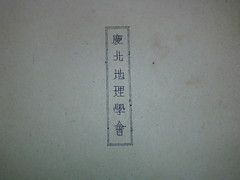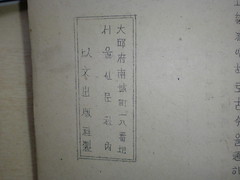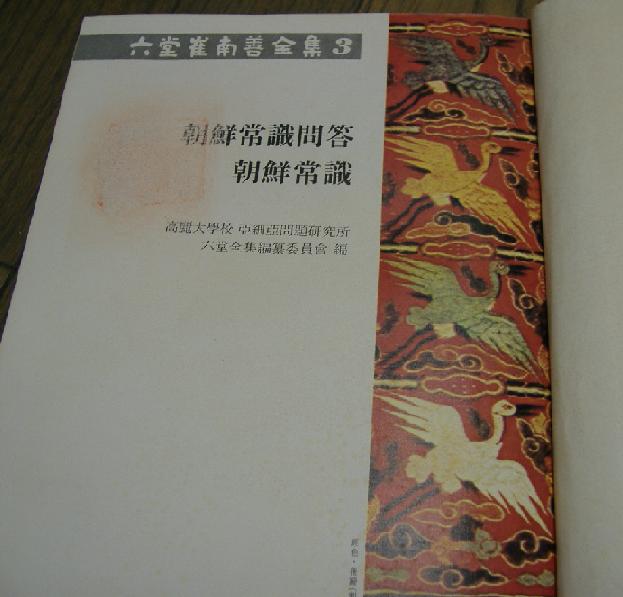 "Geography for Middle School(中等地理)" is a textbook, published by a Korean company 以文社 in Daegu(大邱) city and probably handwritten and printed by some kind of mimeograph machine. We don't know when it was exactly printed, but it should be after 1945, the year Korea gained the Independence. The book also tells that the author is the Association of Gyeongbuk Geographers(慶北地理學會). 慶北 is the abbreviation for Gyeongsangbuk-do (North Gyeongsang Province:慶尚北道). Ulleung County(鬱陵郡), which Ulleungdo and "Dokdo" supposed to belong to, is in 慶北, and Geographer in 慶北 should have been well informed about geography of Ulleungdo.
"Geography for Middle School(中等地理)" is a textbook, published by a Korean company 以文社 in Daegu(大邱) city and probably handwritten and printed by some kind of mimeograph machine. We don't know when it was exactly printed, but it should be after 1945, the year Korea gained the Independence. The book also tells that the author is the Association of Gyeongbuk Geographers(慶北地理學會). 慶北 is the abbreviation for Gyeongsangbuk-do (North Gyeongsang Province:慶尚北道). Ulleung County(鬱陵郡), which Ulleungdo and "Dokdo" supposed to belong to, is in 慶北, and Geographer in 慶北 should have been well informed about geography of Ulleungdo. 中等地理
中等地理序説
朝鮮의四極●度経度
極東 東経一三〇度五六分(●陵島東端)
極西 西経一二四度一一分(鴨緑江薪島西端)
極南 北緯三三度六分(済洲島南端) 極北 北緯四三度(咸鏡北道北端)
--------------------------------------
Geography for Middle School
Preface
Joseon's quadrupolar, latitudes and longitudes
The Far East 130°56" east ( The eastern edge of Ulleungdo)
The Far West 124°11" west (The western edge of Sindo,Yalu River)
The Far South 33°6" (The southern edge of Jeju island) The Far North 43° north (North end of North Hamgyŏng)
As you may have noticed, the longitude of Takeshima/Liancourt Rocks/Dokdo is 131°52′0″E, and it completely outside of 130°56" E. In other words, from this documents it is crystal clear that Korean Geographers considered that "Dokdo" is not Ulleungdo's adjunct island at all, since it is Ulleungdo's neighbouring island of Jukdo(竹島), which locates 130°56" E, not Japanese Takeshima(竹島). This fact coincides with the description of famous Korean geographer and historian Choi Nam-seon(崔南善)'s book entitled, “Common Questions and Answers about Joseon(朝鮮常識問答)” (1946).
Mr. Choi also wrote the following in his 1948 book "朝鮮常識":
“Question: Where is our country located on a map?”
“Answer: The peninsula, itself, is located from an east longitude of 130 degrees, 41 minutes, 22 seconds to 124 degrees, 18 minutes, 35 seconds, and from a north latitude of 34 degrees, 14 minutes, 16 seconds to 43 degrees, 0 minutes, 36 seconds. If islands (large and small) are included, east longitude is from 130 degrees, 56 minutes, 23 seconds to 124 degrees, 11 minutes, 00 seconds, and north latitude is from 33 degrees, 6 minutes, 40 seconds to 43 degrees, 0 minutes, 36 seconds.”
“Question: Where are the farthest north, south, east, west boundaries of our country?”
“Answer: On the peninsula, the farthest eastern point is Noseo-myeon, in Gyeongheun County of North Hamgyeong Province. The farthermost western point is Yongcheon-myeon, in Yongcheon Country of North Pyeongan Province. The farthest southern point is Songji-myeon, in Haenam County of South Jeolla Province. The farthest northern point is Yupo-myeon, in Eunseong County of North Hamgyeong Province.”
“If islands are included, the fartest eastern point is Jukdo, in Ulleung County of North Gyeongsang Province. The farthest western point is Ma-an-ri, Sindo-myeon, in Yongcheon County of North Pyeongan Province. The farthest southern point is
Marado, Daejeong-myeon, in Jejudo of South Jeolla Province. The farthest northern point is Yupo-myeon, in Eunseong County of North Hamgyeong Province.”
Mr. Choi clearly wrote that Korea’s farthermost eastern point was “Jukdo, in Ulleung County of North Gyeongsang Province.” As can be seen on the modern map of Ulleungdo above, Jukdo is a small island about two kilometers off Ulleungdo’s east shore. (Images of Choi's books are from reprinted book.)
極東 東経一三〇度五六分二三秒This 竹島 is not Japanese Takeshima/Liancourt Rocks/Dokdo, but Jukdo. When Japanese got confused the numbers, names and locations of the islands in the Sea of Japan due to the misplotted Western maps and old Korean maps which placed Usando to the west of Ulleungdo after the Meiji Restoration in 1867, the government of Japan sent Warship Amagi to survey Ulleungdo and "finally came to understand the situation when I (Kitazawa, a MOFA official ) learned that "Matsushima" (松島) was Ulleungdo, and the other island, which was called Takeshima (竹島), was just a rock (竹嶼 - Jukdo or Boussole Rock). " Then the islands was decided to call "竹嶼(Korean name 竹島:Jukdo)" by Japanese in 1882, and Korean followed Japanese and started to call this neighbouring island of 4km away from Ulleungdo, which they used to call Usando, as Jukdo(竹島). Korean considered the easternmost of Ulleungdo, which naturally makes the island Jukdo the easternmost of Korean territory. In spite of the confusion in 1860s-80s, Japanese officials knew "ホルネットロックス/ホウルリロック : Hornet Rocks " or "リャンコ島 : Liancourt Rocks", today's Japanese Takeshima, is Japan's while they never ever considered as Korean territory.
(慶尚北道鬱陵島竹島)
As we could see in the following references, there is no single document that suggests Korean government and intellectuals even perceived accurately where their "Dokdo" is nor had a clear conception that it was their territory before 1950s, when they militarily occupied the island illegaly against Japan's official firm protest.
References ;
Lies, Half-truths, and Dokdo Video, Part 11 : 大韓全図(1899), 大韓新地誌(1907), 崔南善「朝鮮常識問答」(1946) 「朝鮮常識」(1948)
1900 - The Times Map (China and Japan, Printing House, London)**It shows Ulleungdo = Korean , Liancourt Rocks = Japanese
1901 - "Daehanjiji" (大韓地誌) Map of Korea's Gangwon Province (玄采)
1906 - "Daehan Jiji" (大韓地誌) by Hyeon Chae (玄采)
1907 - "Chodeung Daehan Jiji" (初等大韓地誌)
1907 June - "Sinpyeon Daehan Jiri" (新編 大韓地理)
1907 - Daehan Shinjiji Attached Maps (大韓新地志附地圖)
1922 - "Map of Daehanminguk" (대한민국 디도) (大韓民国図)
1954 - Korean map didn't include Liancourt Rocks " Korea: Her History and Culture" Office of Public Information, Republic of Korea"
Korean Eastern limits described in various books world wide exclude Takeshima/Dokdo from Korean Territory
Sugino Yomei's blog page "★ハングルで書かれた「朝鮮の東端」" (Japanese)



If anybody has any information on this book, 慶北地理學會, 以文社 or anything else, please let me know.
ReplyDeleteBTW, I admire this almost hand-made textbook, probably by geographers and teachers who must have devoted themselves making a new Korea's own textbook after liberation. Especially, the point that they were honest about Dokdo being outside of their territory.
Wow!!!
ReplyDeleteGJ, Kaneganese.
I hope young Korean people who were educated the myth of Dokdo in school (maybe after 1954) will notice the fact that myth was made up by Korean governments.
Very very good job!
ReplyDeleteIt is time to update Korea's Easternmost boundary series?
http://dokdo-or-takeshima.blogspot.com/2008/06/korean-eastern-limits-described-in.html
Thanks, guys
ReplyDeleteGTOMR,
Yes, it's time to revise the post. Thank you for reminding me.
This comment has been removed by the author.
ReplyDeleteI have noticed pro-Japanese people like to cite Choi Nam-seon's description of Chosun's eastern boundary. But they should first know what kind of person he was before concluding his statement is favorable to Japan.
ReplyDeleteAt the early period of Japanese colonial ruling in Korea, Choi Nam-seon was a nationalist historian and independence activist who drafted the Declaration of Independence for the March 1st Movement in 1919 and imprisoned because of his involvement, but later he turned into a apostate(変節者).
He was a member of the Korean History Compilation Committee(朝鮮史編修會) established in 1925 by Japanese Residency-General in Korea(統監府). What Korean History Compilation Committee did was collecting Korean historical materials and doing a compilation of Korean history from Japanese colonial point of view. The Committee dared to distort the Korean history to validate Japanese colonization of Korea.
Choi Nam-seon also served as a member of an orgnization (中樞院 ) established by Japanese Office of the Governors-General of Korea (朝鮮総督府). The Korean members of 中樞院 were the collaborators for Japanese Imperialism against Korea. What this organization mainly did was making a propaganda for the justice of the Japanese forceful annexation of Korea. Choi Nam-Seon wrote many pro-Japanese speeches and articles until the liberation of Korea in 1945.
After the liberation of Korea. he was arrested for his collaboration with the Imperical Japanese.
"朝鮮常識問(1946)" and "朝鮮常識(1948)" were published after the liberation of Korea, but they were based on the "朝鮮常識" which he serially published in Maeil Newspaper(1937) during the Japanese colonial ruling period.
It's hard to say whether Choi Nam-seon knew Dokdo was Korean land or not, but sure thing is he was not in the position to write the truth about Dokdo. Even in case he knew Korean ownership of Dokdo, he must have had no other choice but to exclude Dokdo as Koran territory as a "pro-Japanese collaborator. (There is a possibility that he knew Dokdo was Korean land because it was he who advised President Rhee to claim Dokdo.)
Even thought he believed Dokdo was not Korean land, it doesn't matter. Choi Nam-seon's definition of Korean easternmost boundary is nothing but a wrong personal perception on Dokdo of a collaborator for Imperial Japan which illegally annexed Dokdo. Thus his personal view is meaningless in Dokdo issue.
Instead, let me introduce really meaningful Japanese textbooks which clearly show Dokdo is Korean land even after Japanese illegal incorporation of Korea. If you see the maps in those textbook, you'll realize Choi Nam-seon's book is meaningless.
等地理書附圖(1934)
尋常小学国史絵図(1939)
There are more maps which prove Japan considered Dokdo as Korean land even after Japanese Incorporation of Dokdo in 1905.
日本陸地測量部発行地図区域一覧図(1936)
內務省地理調査所發行地圖一覽圖 (1946)
日本新分縣地圖-島根縣 (1946)
In conclusion, "Geography for Middle School(中等地理)" may have referenced Choi Nam-seon's wrongful description of Korean eastern boundary and his pro-Japanese perception as a collaborator for Imperial Japan is not meaningful at all.
If pro-Japanese people truly want to know the truth, they should try to focus more on the abundant evidence from Japanese historical materials proving Dokdo is Korean land.
This comment has been removed by the author.
ReplyDeleteCorrection :
ReplyDeleteHe was a member of the Korean History Compilation Committee(朝鮮史編修會) established in 1925 by Japanese Residency-General in Korea(統監府).
--> He was a member of the Korean History Compilation Committee(朝鮮史編修會) established in 1916 by the Japanese Office of the Governors-General of Korea (朝鮮総督府)